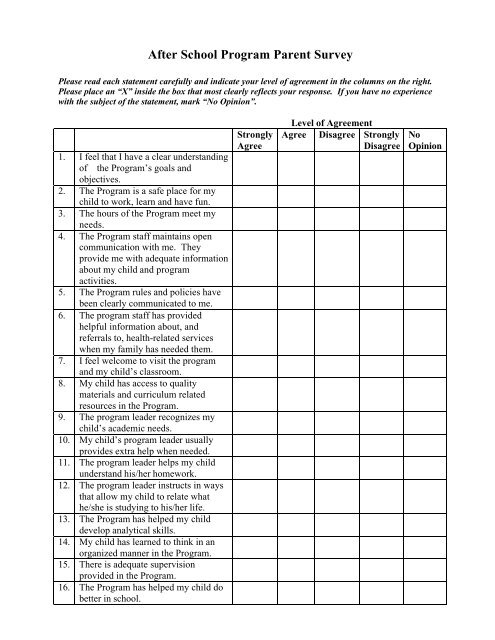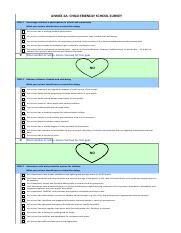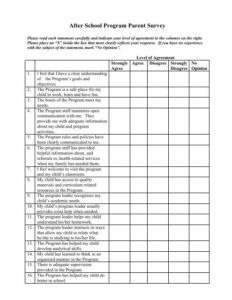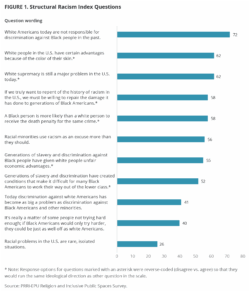Running a successful after school program is incredibly rewarding, but how do you truly know if you’re hitting the mark? It is vital to gather feedback from all stakeholders, including students, parents, and staff, to understand what is working well and where there might be opportunities for growth. A well-designed evaluation survey is your compass, guiding you toward continuous improvement and ensuring your program delivers the maximum benefit to the young people it serves.

Think of it as a direct line to your participants’ experiences and perceptions. Without this valuable input, you might be making assumptions rather than informed decisions about your program’s impact, effectiveness, and overall appeal. By systematically collecting and analyzing feedback, you can celebrate successes, address challenges proactively, and ultimately create an even more impactful and engaging environment for everyone involved.
Crafting a Comprehensive After School Program Evaluation Survey
Developing an effective after school program evaluation survey template requires careful thought to ensure you capture all the necessary information without overwhelming respondents. The goal is to gather actionable insights that can genuinely inform your program’s future. You want to ask questions that are clear, concise, and cover various aspects of the program, from daily activities and learning opportunities to the overall safety and support provided. Consider what specific objectives your program aims to achieve, and then formulate questions that assess whether those objectives are being met from the perspective of the participants and their families.
A truly useful survey will typically include sections that delve into different facets of the program experience. For instance, you might want to know about the quality of the activities offered, the interactions with staff members, or even the convenience of the program’s schedule. Structuring your survey logically helps respondents move through it smoothly and provides you with organized data for analysis. Remember, the better your questions, the more insightful your answers will be, leading to clearer pathways for improvement.
Key Areas to Cover in Your Survey
When you’re putting together your after school program evaluation survey template, it’s helpful to think about distinct categories of information you need. Each category helps paint a fuller picture of the program’s strengths and areas that might need attention. Here are some essential areas to include:
- Program Activities and Content: Are the activities engaging and educational? Do they align with student interests?
- Staff Effectiveness and Interaction: Are staff members supportive, knowledgeable, and good communicators? Do students feel comfortable approaching them?
- Safety and Environment: Is the program space safe, welcoming, and conducive to learning and play?
- Impact and Outcomes: What new skills or knowledge have participants gained? How has the program influenced their school performance or social development?
- Logistics and Communication: Is communication with parents clear and timely? Is the schedule convenient?
- Overall Satisfaction and Recommendations: Would participants or parents recommend the program to others? What suggestions do they have for improvement?
By touching upon these varied aspects, you ensure a holistic review of your after school program. Including both multiple-choice questions for easy data tabulation and open-ended questions for qualitative feedback will give you a rich dataset. The open-ended questions are particularly valuable as they allow respondents to express specific thoughts and experiences in their own words, often revealing insights you hadn’t considered.
Implementing and Leveraging Your Survey Results
Once you have meticulously crafted your after school program evaluation survey template, the next critical step is its implementation and, more importantly, the strategic use of the data you collect. Distributing the survey effectively is paramount. Consider using online survey tools for convenience, but also be prepared to offer paper copies for those who might prefer them or have limited internet access. Ensure you communicate the purpose of the survey clearly to all participants, emphasizing that their honest feedback is invaluable for making the program better for everyone. Timing is also key; surveying too early might not capture the full experience, while too late could mean missing the opportunity to address immediate concerns.
After the surveys are collected, the real work begins: analyzing the results. Look for trends in the quantitative data and recurring themes in the qualitative responses. Are there particular activities that consistently receive high praise? Are there common suggestions for improvement regarding staff interactions or program scheduling? It is crucial to approach this analysis with an open mind, ready to accept both positive affirmations and constructive criticism. Share a summary of the findings with your team, and perhaps even with your program participants and their families, demonstrating that their input is valued and taken seriously.
The ultimate goal of using an after school program evaluation survey template is to drive continuous improvement. Based on your findings, develop an action plan. This might involve introducing new activities, providing additional training for staff, adjusting program schedules, or enhancing communication strategies. Implement these changes, and then, in due course, consider conducting another survey to measure the impact of your adjustments. This cyclical process of evaluation, adaptation, and re-evaluation ensures your after school program remains dynamic, responsive, and maximally beneficial for the children and families it serves, fostering a culture of excellence and ongoing positive development.
Your commitment to gathering and acting upon feedback is what truly sets a high-quality after school program apart. It shows that you are dedicated not just to providing a service, but to consistently refining and improving the experience based on the direct voices of those who matter most. This iterative approach to program development will ensure your efforts genuinely meet the needs and exceed the expectations of your community.



